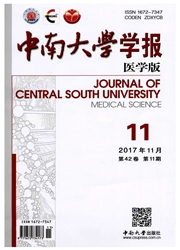

 中文摘要:
中文摘要:
目的:观察低强度脉冲超声(low intensity pulsed ultrasound,LIPUS)对牙本质牙髓复合体损伤修复模型中TGF-β1/Smads信号通路的影响。方法:25只Sprague-Dawley大鼠随机选择5只大鼠作为空白对照组,不予任何处理。剩余20只于双侧上颌第一磨牙采用改良备洞法备洞,建立牙本质牙髓损伤修复模型,右侧为LIPUS组,予以LIPUS辐照(强度为30 m W/cm^2,频率为1.5 MHz,调制信号波宽为200μs,重复率为1 k Hz,20 min/d);左侧为备洞组,予以超声假照处理。分别在辐照1,3,5,7,14 d后处死大鼠,运用免疫组织化学法及图像分析技术检测TGF-β1,Smad 2和3在牙髓组织中的动态表达和定位情况。结果:TGF-β1,Smad 2,3蛋白在正常牙髓组织中均呈弱阳性表达,而在牙本质损伤后出现不同程度的表达增加。备洞组TGF-β1蛋白表达在1 d时增加,在5 d时TGF-β1表达最强,在14 d时表达减弱接近正常水平;与备洞组相比,LIPUS组在3和5 d时表达明显升高(均P〈0.05)。Smad 2,3在LIPUS组及备洞组牙髓中表达均呈现逐步升高的基本变化,其中LIPUS组升高更明显(P〈0.05)。结论:TGF-β1/Smad 2,3信号通路可能参与了牙本质损伤的修复过程,LIPUS在牙本质损伤修复早期可上调TGF-β1,Smad 2,3的表达,可能参与并促进了牙本质牙髓复合体的损伤修复过程。
 英文摘要:
英文摘要:
Objective: To explore the effect of low intensity pulsed ultrasound (LIPUS) on TGF-β1/Smad 2,3 signal pathway during the dentin injury and repair. Methods: Among 25 Sprague-Dawley rats, 5 rats served as a blank control group without treatment. The remaining 20 rats received modified caries preparation inbilateral maxillary first molars to establish a model of dentin-pulp injury and repair. The right maxillary first molars served as a LIPUS groupj which received LIPUS irradiation (frequency: 1.5 MHz, pulse width: 200 μs, pulse repetition frequency: 1 kHz, spatial averaged temporal averaged intensity: 30 mW/cm2, 20 min/d), and the left maxillary first molars served as a cavity-prepared group, which received fake LIPUS irradiation. The rats were sacrificed at 1, 3, 5, 7 and 14 days after LIPUS irradiation. Immunohistochemical staining and Image-pro plus 6.0 were applied to detect the expression and distribution of transforming growth factor-beta1 (TGF-β1) and small mothers against decapentaplegic 2/3(Smad 2 and Smad 3). Results: Immunohistochemical staining showed that the expression of TGF-β1 and Smad 2, 3 were low innormal pulp, but they were increased in different degree after dentin injury. The result of image analysis showed that the expression of TGF-β1 in the cavity-prepared group gradually increased at the first day and peaked at day 5, and then it returned to normal level at day 14. However, the expression of TGF-β1 in the LIPUS group were significantly higher than that in the cavity-prepared group at day 3 and 5 (both P〈0.05). The expressions of Smad 2,3 in both the LIPUS group and the cavity-prepared group were consistently increased all the way, but the expressions in the LIPUS group were higher compared with that in the cavity-prepared group (P〈0.05). Conclusion: The TGF-β1/Smad 2, 3 signal pathway can be activated during the dentin injury and repair. LIPUS can up-regulate the expression of TGF-β1 and Smad 2, 3 in the early period, which may take part
 同期刊论文项目
同期刊论文项目
 同项目期刊论文
同项目期刊论文
 期刊信息
期刊信息
